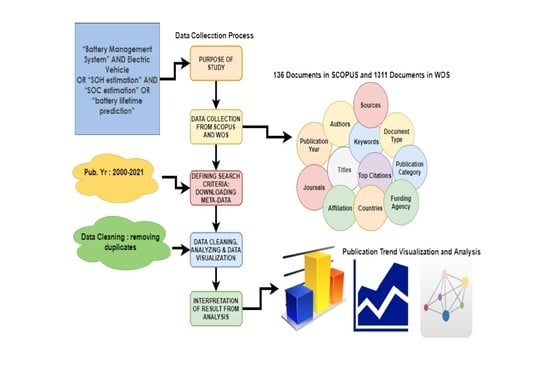Analysis of Electric Vehicle Battery State Estimation Using Scopus and Web of Science Databases from 2000 to 2021: A Bibliometric Study
Abstract
:1. Introduction
2. Related Work
3. Methodology
3.1. Significant Keywords
3.2. Preliminary Analysis
- S is the standard deviation, and
- n is the sample size.
4. Bibliometric Analysis
5. Challenges and Future Perspective
6. Concluding Remark
Author Contributions
Funding
Institutional Review Board Statement
Informed Consent Statement
Data Availability Statement
Conflicts of Interest
References
- Deng, R.; Liu, Y.; Chen, W.; Liang, H. A Survey on Electric Buses—Energy Storage, Power Management, and Charging Scheduling. IEEE Trans. Intell. Transp. Syst. 2021, 22, 9–22. [Google Scholar] [CrossRef]
- Chen, Z.; Zhou, J.; Zhou, F.; Xu, S. State-of-charge estimation of lithium-ion batteries based on improved H infinity filter algorithm and its novel equalization method. J. Clean. Prod. 2021, 290, 125180. [Google Scholar] [CrossRef]
- NaitMalek, Y.; Najib, M.; Bakhouya, M.; Essaaidi, M. On the Use of Machine Learning for State-of-Charge Forecasting in Electric Vehicles. In Proceedings of the 2019 IEEE International Smart Cities Conference (ISC2), Casablanca, Morocco, 14–17 October 2019; pp. 408–413. [Google Scholar] [CrossRef]
- Mawonou, K.S.; Eddahech, A.; Dumur, D.; Beauvois, D.; Godoy, E. State-of-health estimators coupled to a random forest approach for lithium-ion battery aging factor ranking. J. Power Sources 2021, 484, 229154. [Google Scholar] [CrossRef]
- Xiong, R.; Zhang, Y.; Wang, J.; He, H.; Peng, S.; Pecht, M. Lithium-Ion Battery Health Prognosis Based on a Real Battery Management System Used in Electric Vehicles. IEEE Trans. Veh. Technol. 2019, 68, 4110–4121. [Google Scholar] [CrossRef]
- Omariba, Z.; Zhang, L.; Sun, D. Review on Health Management System for Lithium-Ion Batteries of Electric Vehicles. Electronics 2018, 7, 72. [Google Scholar] [CrossRef]
- Wagle, S.A.; Harikrishnan, R. A Bibliometric Analysis of Plant Disease Classification with Artificial Intelligence Based on Scopus and WOS. 2021. Available online: https://www.researchgate.net/profile/Shivali-Wagle/publication/350092508_A_Bibliometric_Analysis_of_Plant_Disease_Classification_with_Artificial_Intelligence_based_on_Scopus_and_WOS/links/6062165f458515e8347d7837/A-Bibliometric-Analysis-of-Plant-Disease-Classification-with-Artificial-Intelligence-based-on-Scopus-and-WOS.pdf (accessed on 26 June 2022).
- Secinaro, S.; Brescia, V.; Calandra, D.; Biancone, P. Employing bibliometric analysis to identify suitable business models for electric cars. J. Clean. Prod. 2020, 264, 121503. [Google Scholar] [CrossRef]
- Cabeza, L.F.; Frazzica, A.; Chàfer, M.; Vérez, D.; Palomba, V. Research trends and perspectives of thermal management of electric batteries: Bibliometric analysis. J. Energy Storage 2020, 32, 101976. [Google Scholar] [CrossRef]
- Raboaca, M.S.; Bizon, N.; Grosu, O.V. Energy management strategies for hybrid electric vehicles-vosviwer bibliometric analysis. In Proceedings of the 2020 12th International Conference on Electronics, Computers and Artificial Intelligence (ECAI), Bucharest, Romania, 25–27 June 2020; pp. 1–8. [Google Scholar] [CrossRef]
- Ramirez Barreto, D.A.; Ochoa Guillermo, E.V.; Peña Rodriguez, A.; Cardenas Escorcia, Y.D. Bibliometric analysis of nearly a decade of research in electric vehicles: A dynamic approach. ARPN J. Eng. Appl. Sci. 2018, 13, 4730–4736. [Google Scholar]
- Gochhait, D.S.; Sudheesh, V.I. Trend Analysis of Electric Vehicles through Web Of Science: A Bibliometric Analysis. Eur. J. Mol. Clin. Med. 2020, 7, 2595–2603. [Google Scholar]
- Pan, Y.; Ren, D.; Kuang, K.; Feng, X.; Han, X.; Lu, L.; Ouyang, M. Novel non-destructive detection methods of lithium plating in commercial lithium-ion batteries under dynamic discharging conditions. J. Power Sources 2022, 524, 231075. [Google Scholar] [CrossRef]
- Donthu, N.; Kumar, S.; Mukherjee, D.; Pandey, N.; Lim, W.M. How to conduct a bibliometric analysis: An overview and guidelines. J. Bus. Res. 2021, 133, 285–296. [Google Scholar] [CrossRef]
- Zhang, P.; Yan, F.; Du, C. A comprehensive analysis of energy management strategies for hybrid electric vehicles based on bibliometrics. Renew. Sustain. Energy Rev. 2015, 48, 88–104. [Google Scholar] [CrossRef]
- Bian, X.; Wei, Z.G.; Li, W.; Pou, J.; Sauer, D.U.; Liu, L. State-of-Health Estimation of Lithium-ion Batteries by Fusing an Open-Circuit-Voltage Model and Incremental Capacity Analysis. IEEE Trans. Power Electron. 2021, 37, 2226–2236. [Google Scholar] [CrossRef]
- Ecker, M.; Nieto, N.; Käbitz, S.; Schmalstieg, J.; Blanke, H.; Warnecke, A.; Sauer, D.U. Calendar and cycle life study of Li(NiMnCo)O2-based 18650 lithium-ion batteries. J. Power Sources 2014, 248, 839–851. [Google Scholar] [CrossRef]
- Cuma, M.U.; Koroglu, T. A comprehensive review on estimation strategies used in hybrid and battery electric vehicles. Renew. Sustain. Energy Rev. 2015, 42, 517–531. [Google Scholar] [CrossRef]
- Ecker, M.; Gerschler, J.B.; Vogel, J.; Käbitz, S.; Hust, F.; Dechent, P.; Sauer, D.U. Development of a lifetime prediction model for lithium-ion batteries based on extended accelerated aging test data. J. Power Sources 2012, 215, 248–257. [Google Scholar] [CrossRef]
- Lu, L.; Han, X.; Li, J.; Hua, J.; Ouyang, M. A review on the key issues for lithium-ion battery management in electric vehicles. J. Power Sources 2013, 226, 272–288. [Google Scholar] [CrossRef]
- Noura, N.; Boulon, L.; Jemeï, S. A Review of Battery State of Health Estimation Methods: Hybrid Electric Vehicle Challenges. World Electr. Veh. J. 2020, 11, 66. [Google Scholar] [CrossRef]
- Park, S.; Ahn, J.; Kang, T.; Park, S.; Kim, Y.; Cho, I.; Kim, J. Review of state-of-the-art battery state estimation technologies for battery management systems of stationary energy storage systems. J. Power Electron. 2020, 20, 1526–1540. [Google Scholar] [CrossRef]
- Waag, W.; Fleischer, C.; Sauer, D.U. Critical review of the methods for monitoring of lithium-ion batteries in electric and hybrid vehicles. J. Power Sources 2014, 258, 321–339. [Google Scholar] [CrossRef]
- Xiong, R.; Cao, J.; Yu, Q.; He, H.; Sun, F. Critical Review on the Battery State of Charge Estimation Methods for Electric Vehicles. IEEE Access 2018, 6, 1832–1843. [Google Scholar] [CrossRef]
- Zhang, J.; Lee, J. A review on prognostics and health monitoring of Li-ion battery. J. Power Sources 2011, 196, 6007–6014. [Google Scholar] [CrossRef]
- Burton, M.J.; Ramke, J.; Marques, A.P.; Bourne, R.R.A.; Congdon, N.; Jones, I.; Tong, B.A.M.A.; Arunga, S.; Bachani, D.; Bascaran, C.; et al. The Lancet Global Health Commission on Global Eye Health: Vision beyond 2020. Lancet Glob. Health 2021, 9, e489–e551. [Google Scholar] [CrossRef]
- Chen, Y.; Kang, Y.; Zhao, Y.; Wang, L.; Liu, J.; Li, Y.; Liang, Z.; He, X.; Li, X.; Tavajohi, N.; et al. A review of lithium-ion battery safety concerns: The issues, strategies, and testing standards. J. Energy Chem. 2021, 59, 83–99. [Google Scholar] [CrossRef]
- Gao, X.; Liu, H.; Deng, W.; Tian, Y.; Zou, G.; Hou, H.; Ji, X. Iron-Based Layered Cathodes for Sodium-Ion Batteries. Batter. Supercaps 2021, 4, 1657–1679. [Google Scholar] [CrossRef]
- Kumar, S.; Pandey, N.; Lim, W.M.; Chatterjee, A.N.; Pandey, N. What do we know about transfer pricing? Insights from bibliometric analysis. J. Bus. Res. 2021, 134, 275–287. [Google Scholar] [CrossRef]
- Sakhnini, J.; Karimipour, H.; Dehghantanha, A.; Parizi, R.M.; Srivastava, G. Security aspects of Internet of Things aided smart grids: A bibliometric survey. Internet Things 2021, 14, 100111. [Google Scholar] [CrossRef]
- Zhang, Y.; Porter, A.L.; Cunningham, S.; Chiavetta, D.; Newman, N. Parallel or Intersecting Lines? Intelligent Bibliometrics for Investigating the Involvement of Data Science in Policy Analysis. IEEE Trans. Eng. Manag. 2021, 68, 1259–1271. [Google Scholar] [CrossRef]
- Guo, Y.-M.; Huang, Z.-L.; Guo, J.; Guo, X.-R.; Li, H.; Liu, M.-Y.; Ezzeddine, S.; Nkeli, M.J. A bibliometric analysis and visualization of blockchain. Future Gener. Comput. Syst. 2021, 116, 316–332. [Google Scholar] [CrossRef]
- Herrera-Franco, G.; Montalván-Burbano, N.; Carrión-Mero, P.; Jaya-Montalvo, M.; Gurumendi-Noriega, M. Worldwide Research on Geoparks through Bibliometric Analysis. Sustainability 2021, 13, 1175. [Google Scholar] [CrossRef]
- Das, S.; Manna, S.S.; Pathak, B. Recent Trends in Electrode and Electrolyte Design for Aluminum Batteries. ACS Omega 2021, 6, 1043–1053. [Google Scholar] [CrossRef] [PubMed]
- Wang, X.; Wei, X.; Zhu, J.; Dai, H.; Zheng, Y.; Xu, X.; Chen, Q. A review of modeling, acquisition, and application of lithium-ion battery impedance for onboard battery management. ETransportation 2021, 7, 100093. [Google Scholar] [CrossRef]
- Ibrahim, A.; Jiang, F. The electric vehicle energy management: An overview of the energy system and related modeling and simulation. Renew. Sustain. Energy Rev. 2021, 144, 111049. [Google Scholar] [CrossRef]
- Fakhar Manesh, M.; Pellegrini, M.M.; Marzi, G.; Dabic, M. Knowledge Management in the Fourth Industrial Revolution: Mapping the Literature and Scoping Future Avenues. IEEE Trans. Eng. Manag. 2021, 68, 289–300. [Google Scholar] [CrossRef]
- Jia, Y.; Li, J.; Yuan, C.; Gao, X.; Yao, W.; Lee, M.; Xu, J. Data-Driven Safety Risk Prediction of Lithium-Ion Battery. Adv. Energy Mater. 2021, 11, 2003868. [Google Scholar] [CrossRef]
- Shahjalal, M.; Roy, P.K.; Shams, T.; Fly, A.; Chowdhury, J.I.; Ahmed, M.R.; Liu, K. A review on second-life of Li-ion batteries: Prospects, challenges, and issues. Energy 2022, 241, 122881. [Google Scholar] [CrossRef]
- Costa, C.; Barbosa, J.; Gonçalves, R.; Castro, H.; Del Campo, F.; Lanceros-Méndez, S. Recycling and environmental issues of lithium-ion batteries: Advances, challenges and opportunities. Energy Storage Mater. 2021, 37, 433–465. [Google Scholar] [CrossRef]
- Jo, C.; Voronina, N.; Sun, Y.; Myung, S. Gifts from Nature: Bio-Inspired Materials for Rechargeable Secondary Batteries. Adv. Mater. 2021, 33, 2006019. [Google Scholar] [CrossRef]
- Karkera, G.; Reddy, M.A.; Fichtner, M. Recent developments and future perspectives of anionic batteries. J. Power Sources 2021, 481, 228877. [Google Scholar] [CrossRef]
- Leong, K.W.; Wang, Y.; Ni, M.; Pan, W.; Luo, S.; Leung, D.Y.C. Rechargeable Zn-air batteries: Recent trends and future perspectives. Renew. Sustain. Energy Rev. 2022, 154, 111771. [Google Scholar] [CrossRef]
- Liu, S.; Kang, L.; Henzie, J.; Zhang, J.; Ha, J.; Amin, M.A.; Hossain, S.A.; Jun, S.C.; Yamauchi, Y. Recent Advances and Perspectives of Battery-Type Anode Materials for Potassium Ion Storage. ACS Nano 2021, 15, 18931–18973. [Google Scholar] [CrossRef] [PubMed]
- Shah, R.; Gashi, B.; González-Poggini, S.; Colet-Lagrille, M.; Rosenkranz, A. Recent trends in batteries and lubricants for electric vehicles. Adv. Mech. Eng. 2021, 13, 168781402110217. [Google Scholar] [CrossRef]
- Salgado, R.M.; Danzi, F.; Oliveira, J.E.; El-Azab, A.; Camanho, P.P.; Braga, M.H. The Latest Trends in Electric Vehicles Batteries. Molecules 2021, 26, 3188. [Google Scholar] [CrossRef] [PubMed]
- Shen, L.; Du, X.; Ma, M.; Wang, S.; Huang, S.; Xiong, L. Progress and Trends in Nonaqueous Rechargeable Aluminum Batteries. Adv. Sustain. Syst. 2022, 6, 2100418. [Google Scholar] [CrossRef]
- Huang, W.; Feng, X.; Han, X.; Zhang, W.; Jiang, F. Questions and Answers Relating to Lithium-Ion Battery Safety Issues. Cell Rep. Phys. Sci. 2021, 2, 100285. [Google Scholar] [CrossRef]
- Xu, Y.; Xu, X.; Guo, M.; Zhang, G.; Wang, Y. Research Progresses and Challenges of Flexible Zinc Battery. Front. Chem. 2022, 10, 827563. [Google Scholar] [CrossRef] [PubMed]
- Ayodele, B.V.; Mustapa, S.I. Life cycle cost assessment of electric vehicles: A review and bibliometric analysis. Sustainability 2020, 12, 2387. [Google Scholar] [CrossRef]




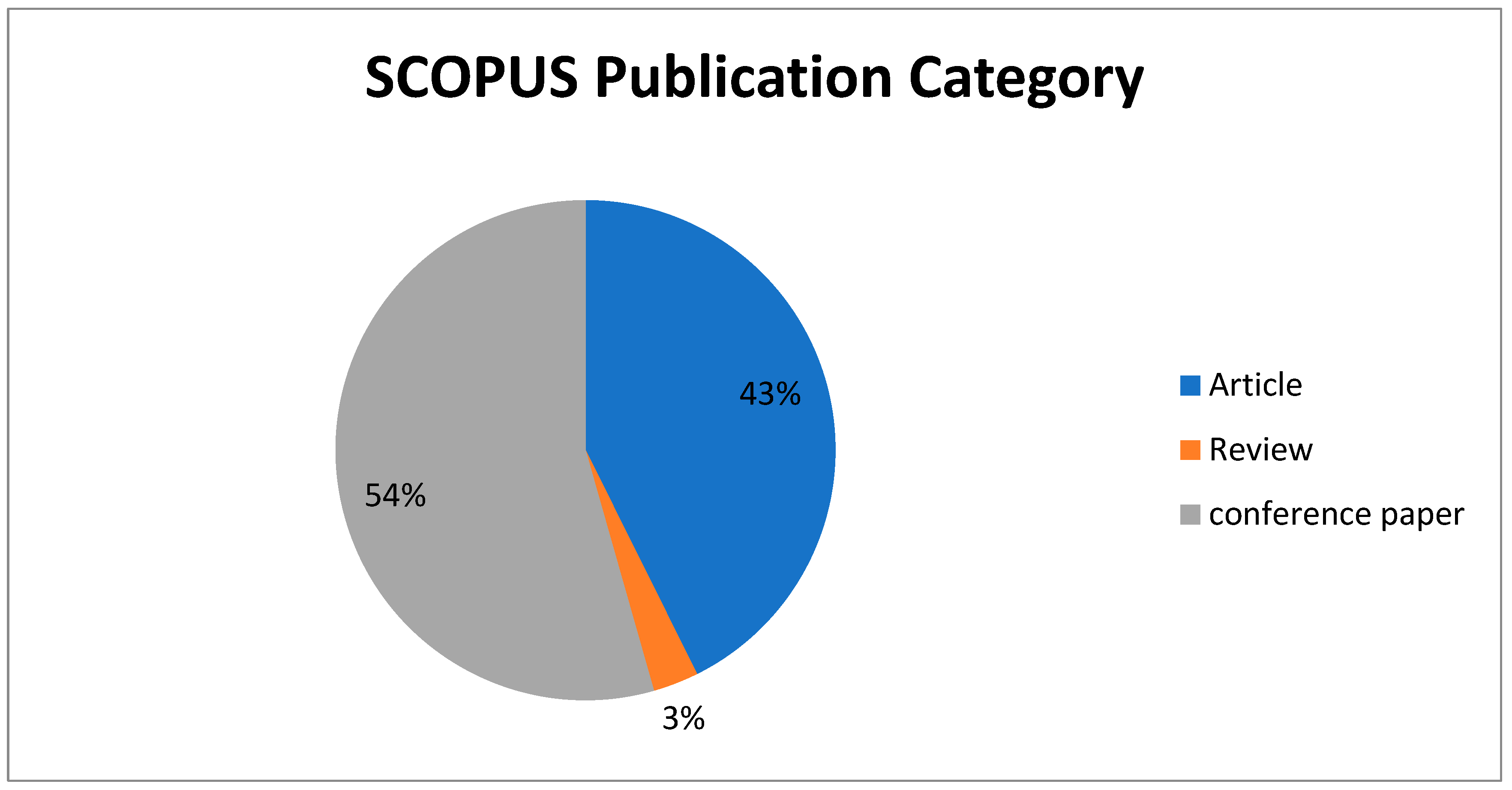



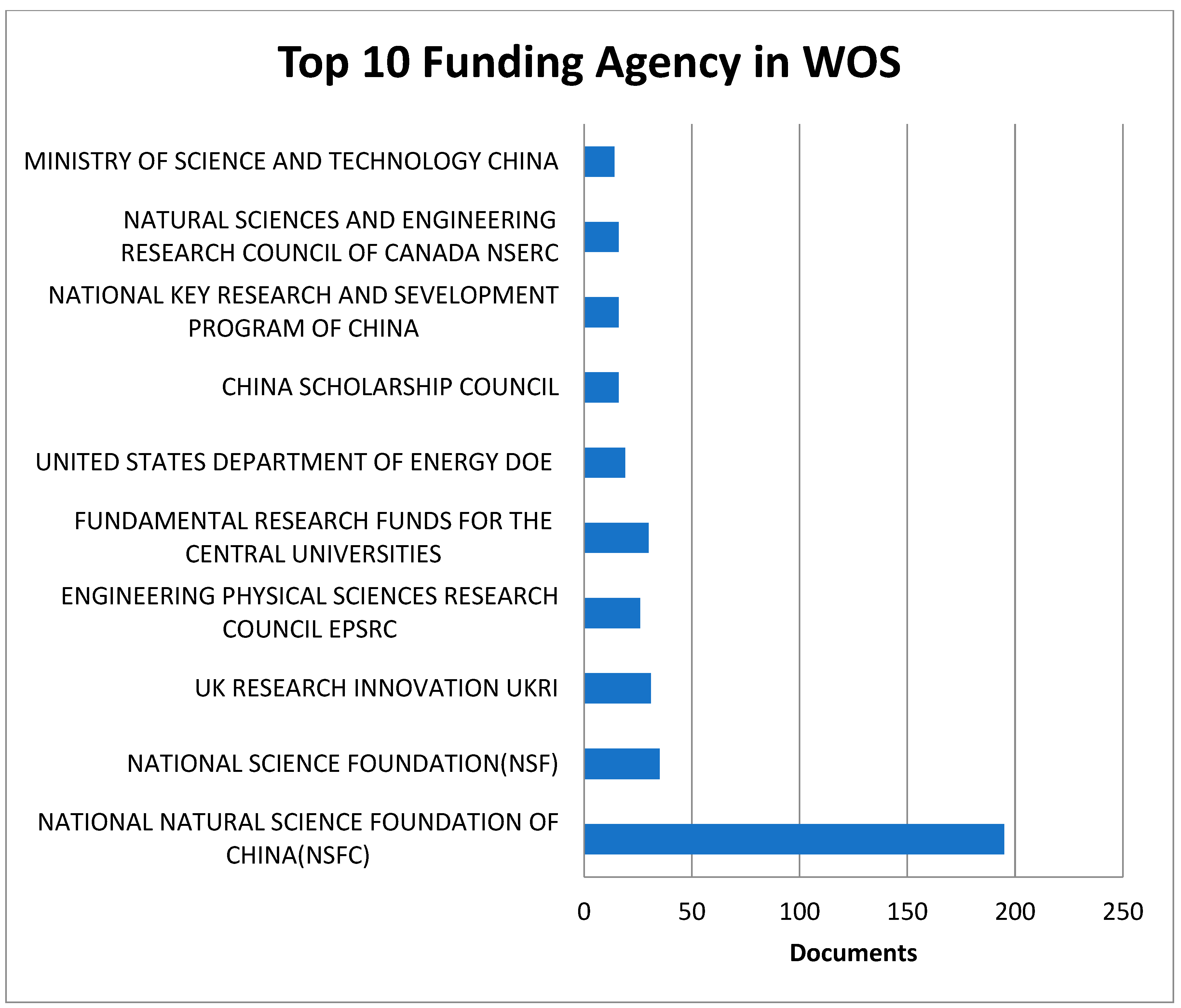
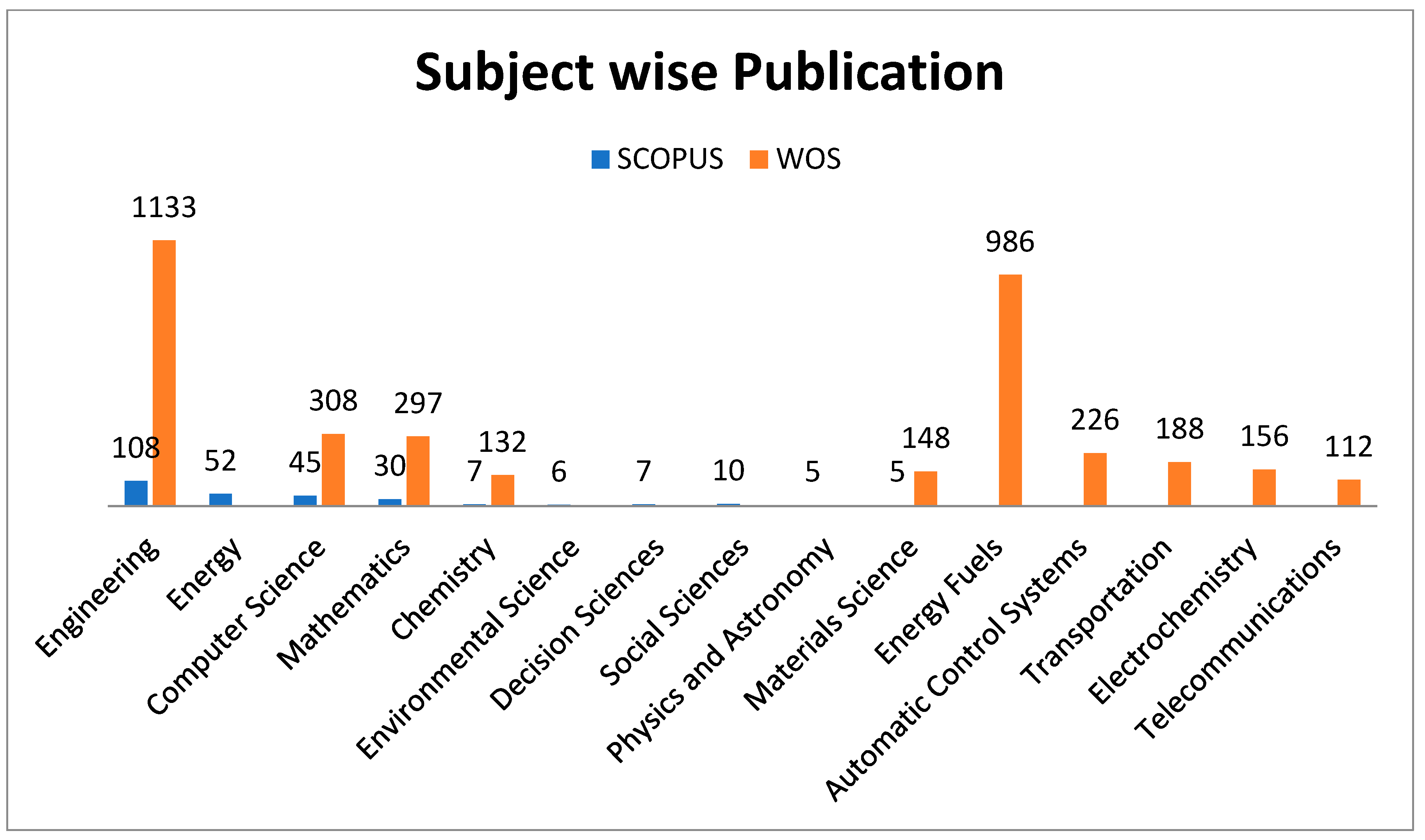
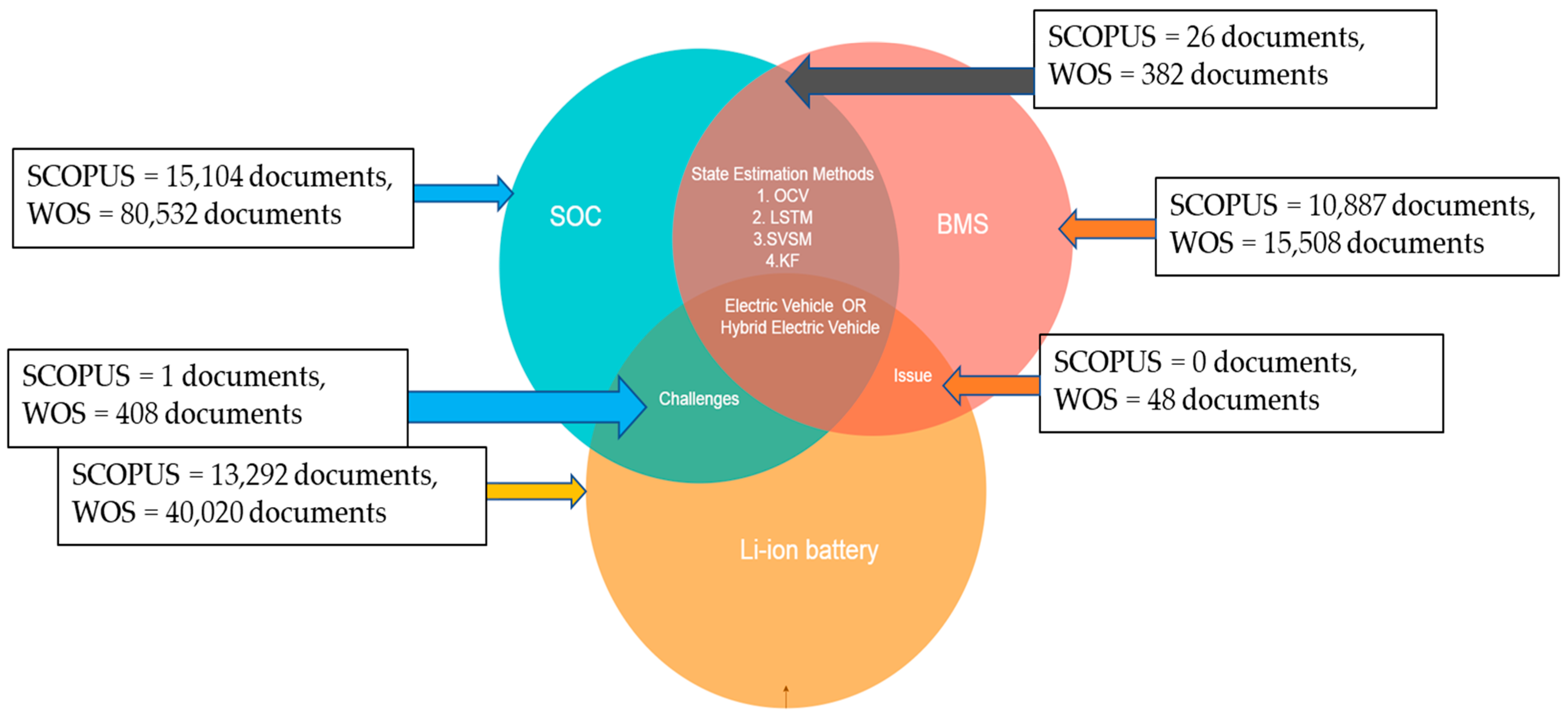

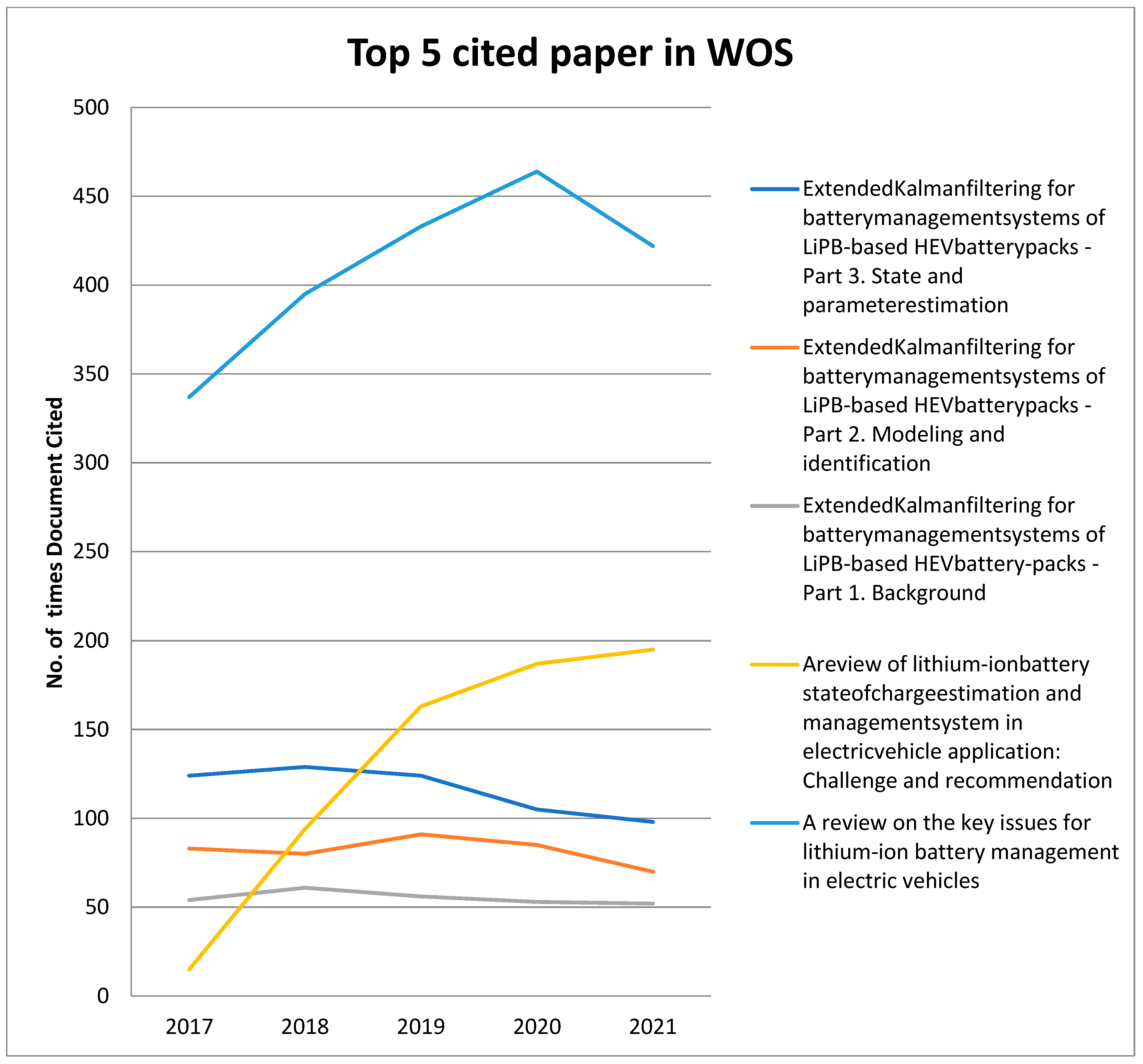

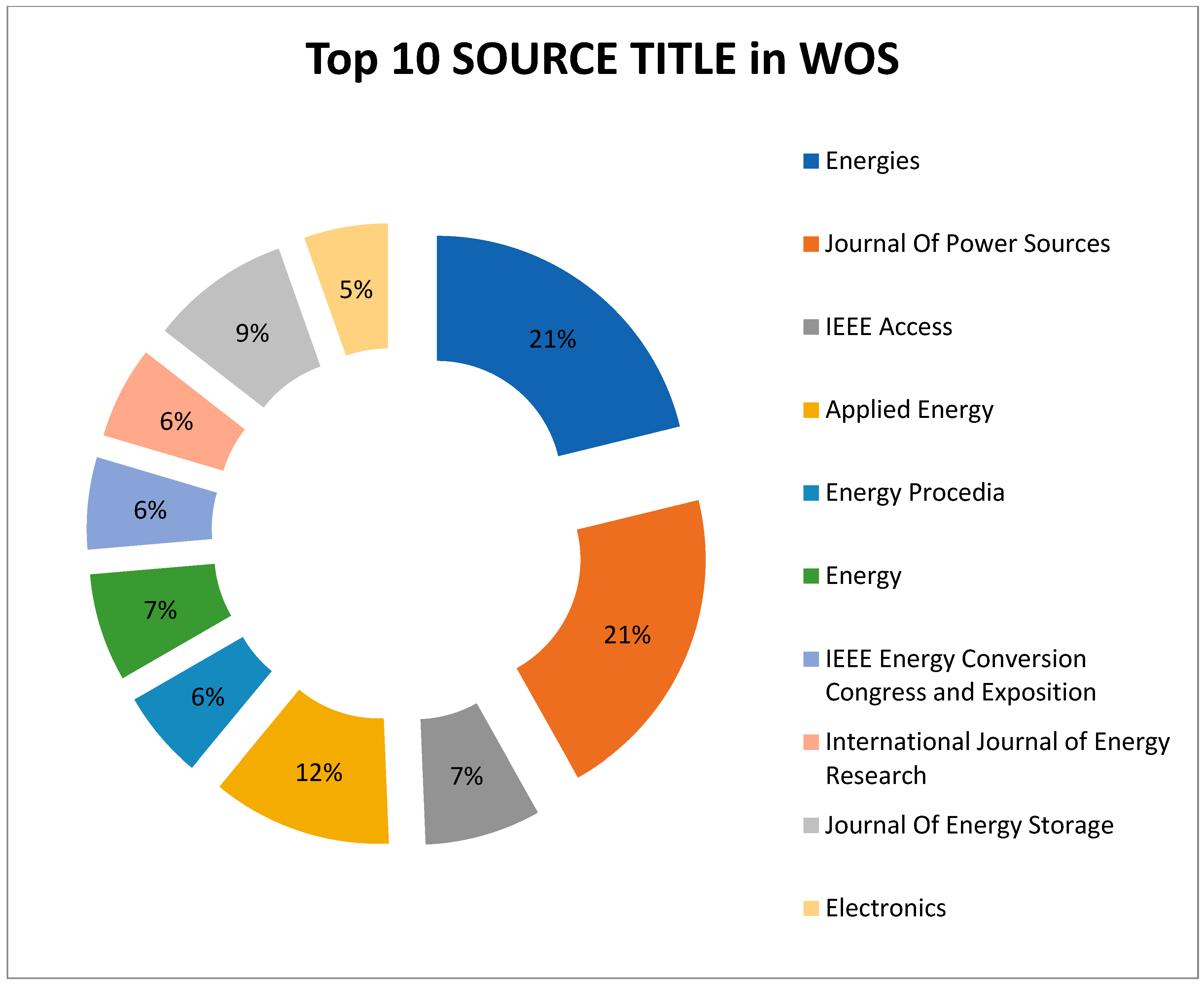

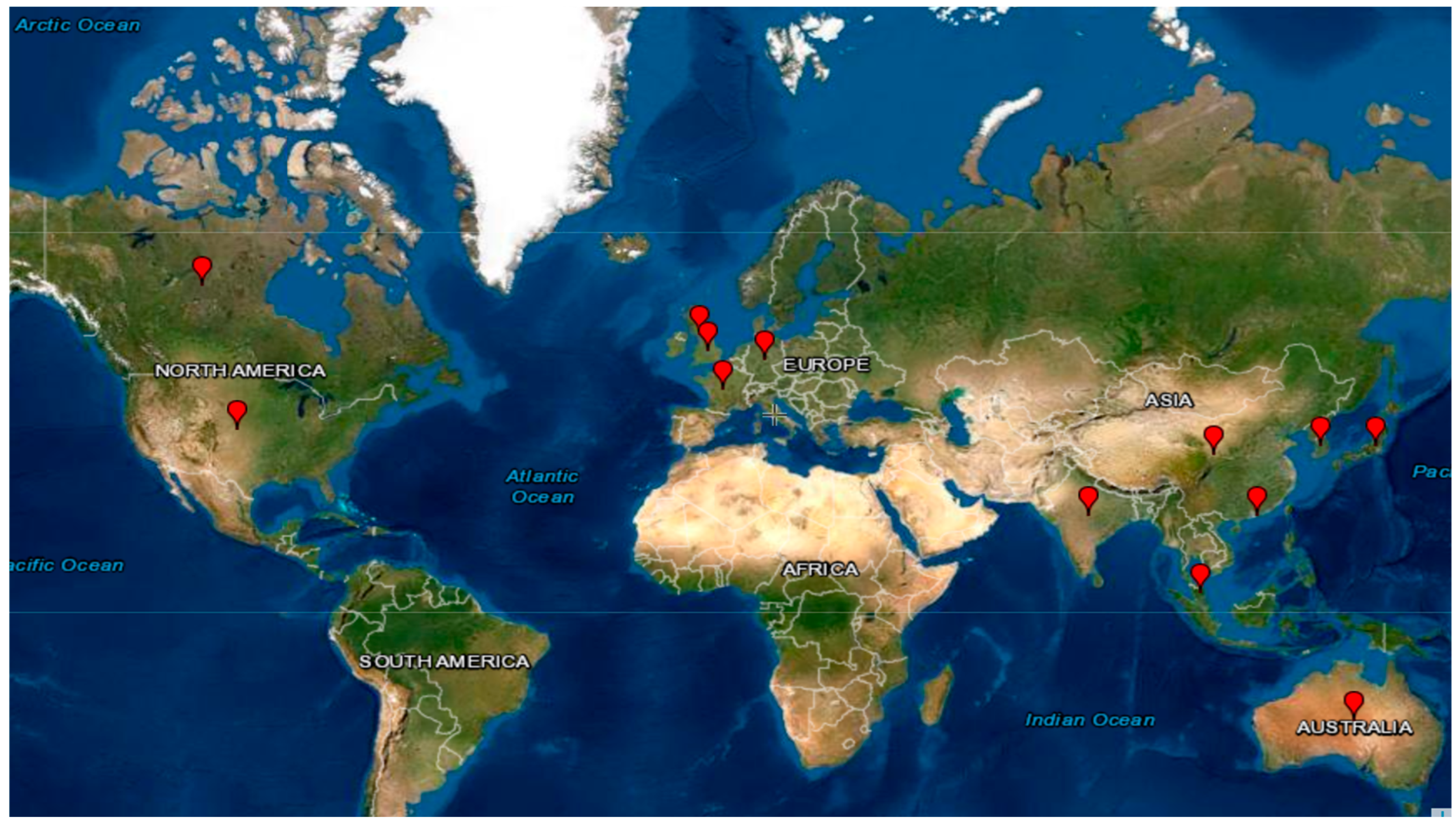

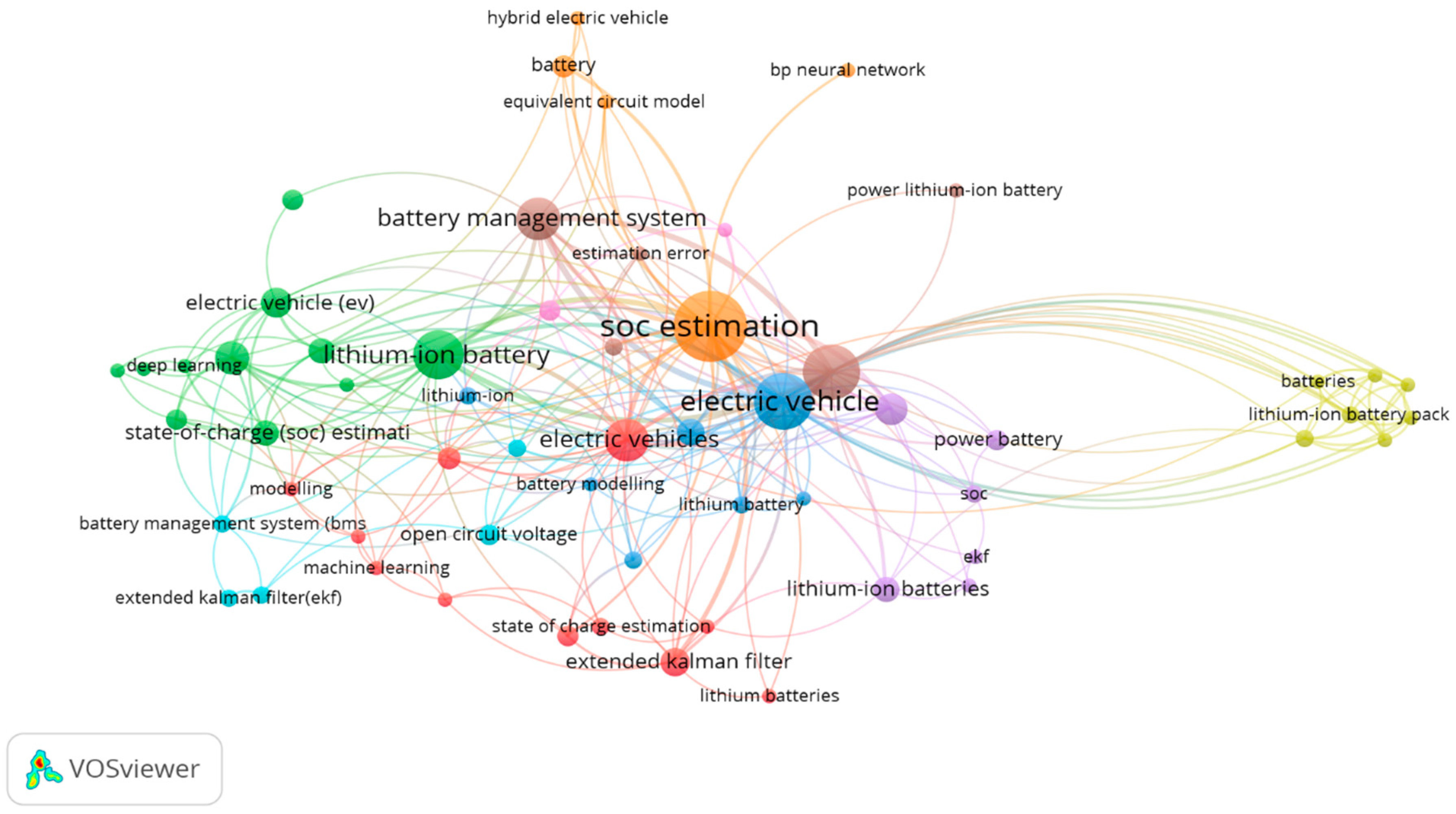
| References | Area of Bibliometric Study | Journal Published | Tools Used |
|---|---|---|---|
| [8] | Business model of electric cars | Journal of Cleaner Production | R-Software, Biblio Shiny |
| [9] | Thermal management of batteries | Journal of Energy Storage | VOSviewer |
| [10] | Energy management in HEVs | International Conference-Electronics, Computers and Artificial Intelligence (ECAI) | VOSviewer |
| [11] | Evolution in EVs over a decade | ARPN Journal of Engineering and Applied Sciences | HitsCite |
| [12] | Identify development in EVs | European Journal of Molecular & Clinical Medicine | VOSviewer |
| [13] | Life-cycle cost analysis of EV | Sustainability | VOSviewer |
| [14] | Blockchain technology | Future Generation Computer Systems | Cite Space, VOSviewer |
| [15] | Energy management in HEVs | Renewable and Sustainable Energy Reviews | Excel |
| Review Document | Discussion | Advantage | Disadvantage |
|---|---|---|---|
| [18] |
| Cover many estimation strategies and parameters which controls and manages vehicle dynamics. | Short discussion on the existing estimation strategies related to vehicle and battery management. Detailed discussion of advantage and disadvantage of different methods is missing. |
| [20] |
| Cover different challenges and techniques to identify parameters in BMS are discussed. | BMS challenges for EV are discussed but comparison of techniques to identify parameter is not discussed. |
| [21] |
| Discuss methods for real-time hybrid EV for accurate timely maintenance. Battery internal resistance is the key indicator for battery degradation. | Discuss few techniques of model-based and ML-based approach for hybrid EV application. Considering battery internal resistance as the key indicator for battery aging whereas other indicators like capacity, humidity, temperature, environment, and driving pattern which also play a major role in battery aging are not considered in this paper. |
| [22] | Different BMS state estimation techniques and their research trends in past 3 years are discussed. |
Research trends in past 3 years in the field of SOC, SOH, SOT, and SOF are discussed in detailed manner. Knowledge about recent research trends will help in further exploration of new techniques to estimate state accurately. | Comparison between different methods of state estimation along with accuracy results and dataset of different battery chemistry under different conditions effect in state estimation are missing in this paper. |
| [23] | Different estimation methods for SOC, SOH, SOP, capacity estimation, RUL and battery impedance estimation for electric and hybrid vehicles are discussed. | Cover different battery state estimation methods in a detailed and flowchart manner. | Advantages and disadvantages of different state-estimation methods on different chemistry and environment conditions of battery are not discussed in this paper. |
| [24] | Detailed discussion of SOC methods and SOC methods for battery. | Different approaches to estimate SOC are discussed. | Comparison between methods of SOC estimation is lacking in this paper. |
| [25] | Review of SOC, voltage estimation, capacity estimation and RUL are discussed. | Parameters and conditions for state-estimation methods used in different literatures are discussed. | Comparison between different estimation methods are lacking in this paper. |
| Keyword Type | Keyword Combination |
|---|---|
| Primary keywords (SCOPUS DB and WOS DB) | “battery management system” AND “electric vehicle” |
| Secondary keywords (SCOPUS DB and WOS DB) | “SOH estimation” AND “SOC estimation” OR “battery lifetime prediction” |
| Operator | Symbol | Description with Example |
|---|---|---|
| Truncation operator | $ | Search zero or more characters in between letters e.g.- colo$r = color, colour |
| Truncation operator | * * | Search zero or more characters in suffix/prefix e.g.- *carbon* = hydrocarbon, carbon, carbonate |
| Truncation operator | ? | Search one character only in between letters e.g.- en?oblast = endoblast, entoblast |
| Boolean operator | AND | All search terms must occur to be retrieved e.g.- stem cell AND lymphoma |
| Boolean operator | OR | Any one of the search terms must occur to be retrieved e.g.- stem cell OR lymphoma |
| Boolean operator | NOT | Excludes records that contain a given search term e.g.- pigment NOT greenIt retrieves pigment terms documents which does not include green |
| Proximity operator | “ ” | In order to search for an exact phrase, enter the term in quotation marks. Use of quotation mark disables the lemmatization of terms. e.g.- “electric vehicle” It shows documents related to electric vehicle term only |
| Countries | Max Publication Countrywise | Highly Cited Papers Countries | Highly Cited Publication Countrywise |
|---|---|---|---|
| China | 72 | Malaysia | 2 |
| India | 16 | China | 28 |
| United States | 15 | Canada | 3 |
| Australia | 6 | United States | 1 |
| Canada | 5 | Singapore | 1 |
| South Korea | 5 | India | 4 |
| United Kingdom | 5 | Australia | 4 |
| Germany | 4 | Iran | 1 |
| Japan | 4 | Turkey | 1 |
| France | 3 | Norway | 1 |
| One Sample t-Test | |||
|---|---|---|---|
| t | df | p | |
| Max Publication Countrywise | 2.026 | 9 | 0.073 |
| Highly Cited Publication Countrywise | 1.749 | 9 | 0.114 |
| Descriptive Statistics | ||||
|---|---|---|---|---|
| Max Publication Countrywise | Highly Cited Publication Countrywise | Countries | Highly Cited Papers Countries | |
| Valid | 10 | 10 | 10 | 10 |
| Mode | 5.000 | 1.000 | ||
| Median | 5.000 | 1.500 | ||
| Mean | 13.500 | 4.600 | ||
| Std. Deviation | 21.067 | 8.316 | ||
| Skewness | 2.898 | 3.033 | ||
| Std. Error of Skewness | 0.687 | 0.687 | ||
| Minimum | 3.000 | 1.000 | ||
| Maximum | 72.000 | 28.000 | ||
| 25th percentile | 4.250 | 1.000 | ||
| 50th percentile | 5.000 | 1.500 | ||
| 75th percentile | 12.750 | 3.750 | ||
| Sr. No. | Publication Year | Document Title | Author Name | Journal Name | Total Citation (<2021) |
|---|---|---|---|---|---|
| 1. | 2017 | A review of lithium-ion battery state of charge-estimation and management system in electric vehicle applications: Challenges and recommendations | Hannan, M.A., et al. | Renewable and Sustainable Energy Reviews | 776 |
| 2. | 2011 | Evaluation of lithium-ion battery equivalent circuit models for state of charge estimation by an experimental approach | He, H., et al. | Energies | 616 |
| 3. | 2014 | State of charge estimation of lithium-ion batteries using the open circuit voltage at various ambient temperature | Xing, Y., et al. | Applied Energy | 444 |
| 4. | 2018 | Long short-term memory networks for accurate state-of-charge estimation of Li-ion batteries | Chemali, E., et al. | IEEE Transactions on Industrial Electronics | 220 |
| 5. | 2018 | Investigatingthe error sources of the online state-of-charge estimation methods for lithium-ion batteries in electric vehicles | Zheng, Y., et al. | Journal of Power Sources | 193 |
| 6. | 2014 | State-of-charge estimation for battery management- system using optimized support-vector-machine for regression | Hu, J.N., et al. | Journal of Power Sources | 133 |
| 7. | 2015 | Electric vehicle state of charge estimation: Nonlinear correlation and fuzzy support vector machine | Sheng, H., et al. | Journal of Power Sources | 121 |
| 8. | 2013 | Battery state of the charge estimation using Kalman filtering | Mastali, M., et al. | Journal of Power Sources | 118 |
| 9. | 2018 | Condition monitoring in advanced battery management systems: Moving horizon estimation using a reduced electrochemical model | Hu, X., et al. | IEEE/ASME Transactions on Mechatronics | 106 |
| 10. | 2016 | Real-time estimation of battery state-of-charge with unscented Kalman-filter and RTOS μCOS-II platform | He, H., et al. | Applied Energy | 81 |
| 11. | 2016 | An adaptive-sliding mode observer for lithium-ion battery state-of-charge and state-of-health estimation in electric-vehicles | Du, J., et al. | Control Engineering Practice | 70 |
| 12. | 2020 | State-of-charge estimation of lithium-ion batteries using LSTM and UKF | Yang, F., et al. | Energy | 59 |
| 13. | 2012 | Estimation of state of charge of lithium-ion batteries used in HEV using robust extended Kalman filtering | Zhang, C., et al. | Energies | 57 |
| 14. | 2006 | Online SOC estimation of high-power lithium-ion batteries used on HEVs | Dai, H., et al. | 2006 IEEE International Conference on Vehicular Electronics and Safety, ICVES | 56 |
| 15. | 2014 | An online state of charge estimation method with reduced prior battery testing information | Xu, J., et al. | International Journal of Electrical Power and Energy Systems | 52 |
| S. No. | Publication Year | Documents Title | Author Name | Journal Name | Total Citation (<2021) |
|---|---|---|---|---|---|
| 1. | 2013 | A review on the key issues for lithium-ion battery management in electric vehicles | Lu, L.G., et al. | Journal of Power-Sources | 2576 |
| 2. | 2004 | Extended Kalman filtering for battery management systems of LiPB-based HEV battery packs—Part 3. State and parameter estimation | Plett, G.L. | Journal of Power-Sources | 1159 |
| 3. | 2004 | Extended Kalman-filtering for battery management systems of LiPB-based HEV battery packs—Part 2. Modeling and identification | Plett, G.L. | Journal of Power-Sources | 959 |
| 4. | 2004 | Extended Kalman -filtering for battery management systems of LiPB-based HEV battery packs—Part 1. Background | Plett, G.L. | Journal of Power-Sources | 747 |
| 5. | 2017 | A review of lithium-ion battery state-of-charge estimation and management system in electric-vehicle applications: Challenges and recommendations | Hannan, M.A., et al. | Renewable & Sustainable-Energy Reviews | 654 |
| 6. | 2014 | Critical review of the methods for monitoring of lithium-ion batteries in electric and hybrid vehicles | Waag, W., et al. | Journal of Power-Sources | 578 |
| 7. | 2013 | Battery management system An overview of its application in the SmartGrid and electric vehicles | Rahimi-Eichi, H., et al. | IEEE Industrial Electronics Magazine | 460 |
| 8. | 2010 | Contribution of Li-Ion batteries to the environmental impact of electric vehicles | Notter, D.A., et al. | Environmental Science & Technology | 439 |
| 9. | 2014 | State of charge estimation of lithium-ion batteries using the open-circuit voltage at various ambient temperatures | Xing, Y.J., et al. | Applied Energy | 402 |
| 10. | 2011 | Adaptive unscented Kalman filtering for state-of-charge estimation of a lithium-ion battery for electric vehicles | Sun, F.C., et al. | Energy | 377 |
| 11. | 2014 | A comparative study of commercial lithium-ion battery cycle-life in electric vehicle: Aging mechanism identification | Han, X.B., et al. | Journal of Power-Sources | 341 |
| 12. | 2016 | Critical review of state of health estimation methods of Li-ion batteries for real applications | Berecibar, M., et al. | Renewable & Sustainable-Energy Reviews | 336 |
| 13. | 2006 | Sigma point Kalman filtering for battery management systems of LiPB-based HEV battery packs—Part 2: Simultaneous state and parameter estimation | Plett, G.L. | Journal of Power-Sources | 335 |
| 14. | 2011 | Battery management system (BMS) and SOC development for electrical vehicles | Cheng, K.W.E., et al. | IEEE Transactions on Vehicular Technology | 323 |
| 15. | 2018 | Critical review on the battery state of charge estimation methods for electric vehicles | Xiong, R., et al. | IEEE Access | 318 |
Publisher’s Note: MDPI stays neutral with regard to jurisdictional claims in published maps and institutional affiliations. |
© 2022 by the authors. Licensee MDPI, Basel, Switzerland. This article is an open access article distributed under the terms and conditions of the Creative Commons Attribution (CC BY) license (https://creativecommons.org/licenses/by/4.0/).
Share and Cite
Swarnkar, R.; Harikrishnan, R.; Singh, M. Analysis of Electric Vehicle Battery State Estimation Using Scopus and Web of Science Databases from 2000 to 2021: A Bibliometric Study. World Electr. Veh. J. 2022, 13, 157. https://doi.org/10.3390/wevj13080157
Swarnkar R, Harikrishnan R, Singh M. Analysis of Electric Vehicle Battery State Estimation Using Scopus and Web of Science Databases from 2000 to 2021: A Bibliometric Study. World Electric Vehicle Journal. 2022; 13(8):157. https://doi.org/10.3390/wevj13080157
Chicago/Turabian StyleSwarnkar, Radhika, R. Harikrishnan, and Mangal Singh. 2022. "Analysis of Electric Vehicle Battery State Estimation Using Scopus and Web of Science Databases from 2000 to 2021: A Bibliometric Study" World Electric Vehicle Journal 13, no. 8: 157. https://doi.org/10.3390/wevj13080157
APA StyleSwarnkar, R., Harikrishnan, R., & Singh, M. (2022). Analysis of Electric Vehicle Battery State Estimation Using Scopus and Web of Science Databases from 2000 to 2021: A Bibliometric Study. World Electric Vehicle Journal, 13(8), 157. https://doi.org/10.3390/wevj13080157





